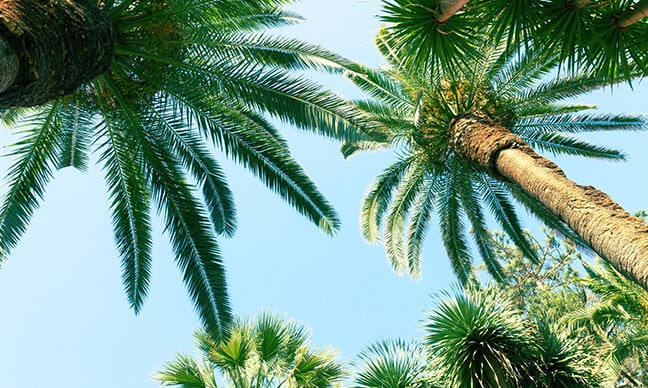Palm trees are amongst the most iconic trees in California. From private landscapes to palm tree street in Los Angeles, they are everywhere in the Golden State. They are a great way to add a tropical appeal on your home. If you are planning to have one on your property, it is crucial to be knowledgeable about palm tree care.
The good news is that palm tree maintenance is pretty straightforward. If you are clueless about how to do it, keep on reading and learn from the tips we’ll share.
Related Post: Palm Tree Trimming
Tips and Tricks for Palm Tree Care
1. Watering
To plant and grow a palm tree successfully, regular watering is one of the most important requirements. A lot of these trees can tolerate extreme heat, but during their younger years, water is a necessity. It helps in establishing its roots properly. For new palms, water them daily. Once it is established, reduce watering to two to three times a week. Water only the topsoil and make sure that the soil does not remain soggy.
Proper timing is also a crucial concern when watering palm trees. In the summer, water them early in the morning or late in the afternoon. Meanwhile, in the winter, watering is best done early morning. Adjust watering based on the season. More water is needed when it is hot. Also, avoid overwatering as it can result in root rot and other palm tree diseases. Check the soil. If it is still moist, then it is a sign that watering is not necessary. During drought, water the top of the tree to help maintain the vigor of the leaves.
2. Soil Amendment
There are different types of palm trees in California, and they might have varying soil needs. Research the variety that you wish to plant to know how you can amend the soil. In most cases, it will need a well-draining and moist soil. Especially when the tree is young, it prefers loose soil to encourage better root growth. Inspect the soil often to see if there are pests and remove them immediately.
If there is excessive alkaline, adding sulfur may be necessary. Manganese, potassium, and magnesium may also be needed by the plant, depending on the problems that are present. When there are low concentrations of essential nutrients in the soil, the tree will suffer from stunted growth and yellowing foliage, among other problems.
3. Proper Pruning
One of the most basic requirements when it comes to palm tree maintenance is pruning. This is crucial to maintain the size and shape of the crown, which largely influences the way it looks. Also, it is a must to get rid of pests and diseases, preventing them from spreading. However, excessive pruning can also be dangerous as it can inhibit the full growth of the tree.
A lot of outdoor palms are tall, making pruning difficult. If that’s the case, ask for help from experts in tree services California. They have innovative tools and skilled experts who can help trim your palm tree. You can be confident that they will be trimming the right parts of the tree and keep it in its best appearance.
4. Fertilize
Like other trees, palm trees need fertilizers to establish full growth. It also prevents the most common palm tree diseases in California. As mentioned earlier, the tree can suffer from nutrient deficiencies and limit its growth. It affects not just the overall health but also the overall appearance. It can quickly become an eyesore in your landscape if it isn’t well-fertilized.
There are different types of fertilizers, including granules, spikes, and pellets. Many of them are applied on the soil, while there are also some that you have to spray directly on the leaf, especially for controlling pests and diseases. It is critical to time the application of the fertilizer depending on when it is needed the most. Also, take note that overfertilizing can do more harm compared to not fertilizing at all.
5. Cleaning
Lastly, you should keep the palm tree and the surrounding area clean. Earlier, we talked about the importance of trimming. Aside from this, there are other ways to clean your palm tree, and that includes getting rid of the scraps around the tree, especially diseased branches, dried leaves, and other things that can harbor pests and spread infection.
Keeping the area clean is also one of the best ways to get rid of palm rats in California. These rats can hide in unexpected places, especially dirt. Once np one is watching, these strong climbers can reach the crown and wreak havoc. Not to mention, they can even get inside your house and destroy wires and other structures.
FAQ
Q: How do you take care of a palm plant?
A: Taking care of a palm plant requires proper positioning to provide for its sunlight needs. It is also important to check the soil. Watch out for the presence of pests and diseases. Regular tree trimming California is also a must to keep the crown neat and healthy. Depending on the variety and location, fertilizing is essential.
Q: What does a palm tree need to survive?
A: To survive, palm trees need moist and well-draining soil. They also require sunlight. Regular pruning, fertilizer, and water are also important. There are drought-tolerant varieties, but when the tree is young, regular watering is a must to establish growth.
Q: How do you maintain a palm tree?
A: Palm tree maintenance requires regular watering until the roots are established. Fertilizing may also be necessary. The most important maintenance requirement is pruning. This will help in maintaining an attractive crown while also preventing pests and diseases.
Local Tree Experts Overview
From fertilizing to pruning, this short guide talked about the must-haves for palm tree care. While many of them are drought-tolerant and hardy, they have specific maintenance requirements, which can vary from one variety to another. Be proactive in taking care of palm trees to establish a good-looking crown and prevent health problems.




